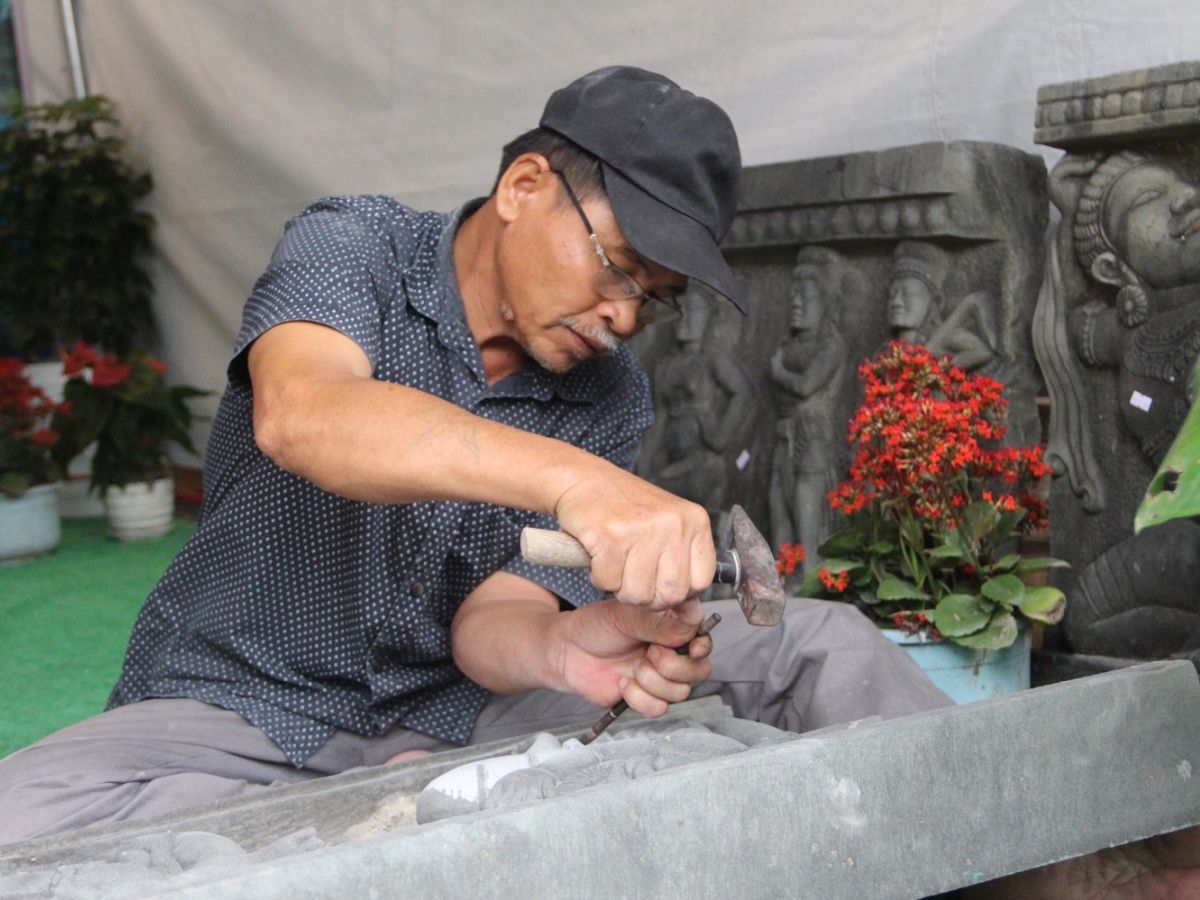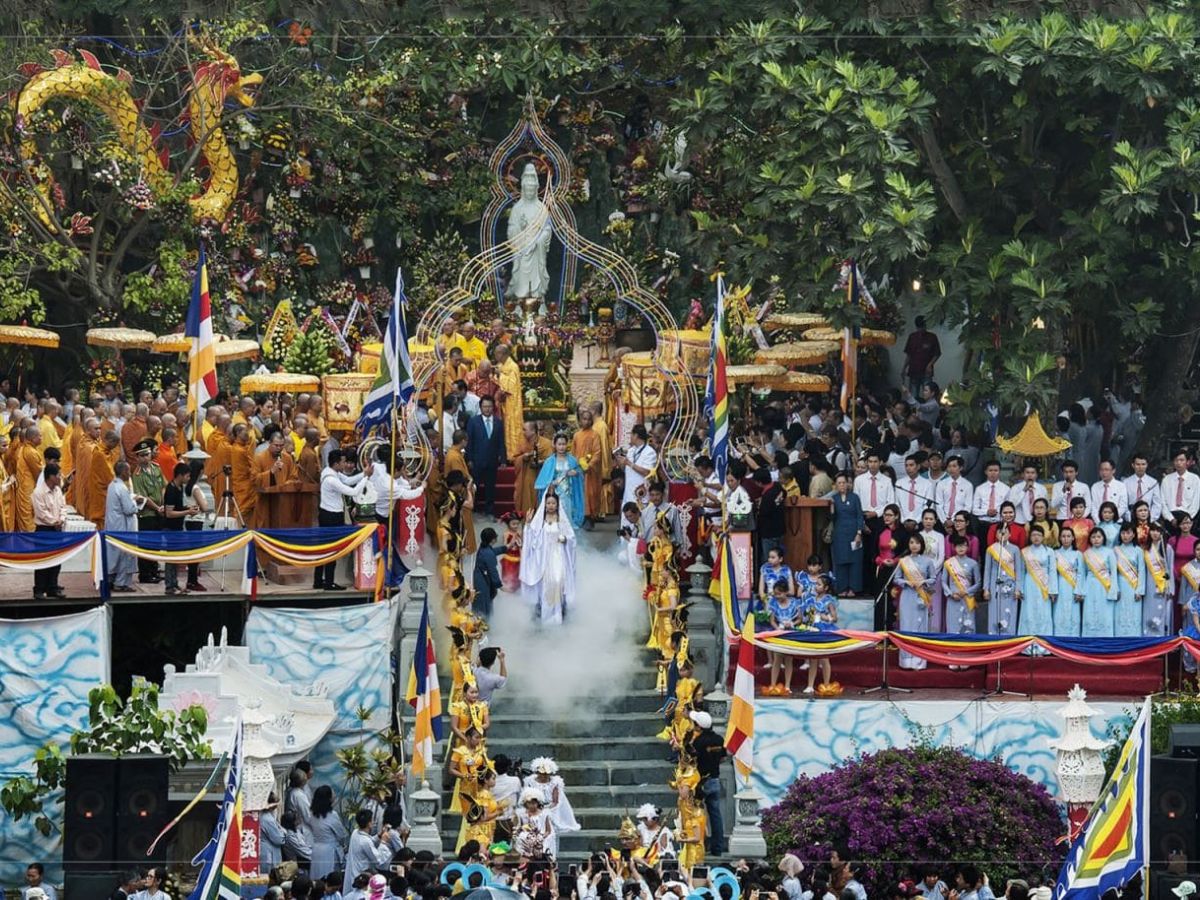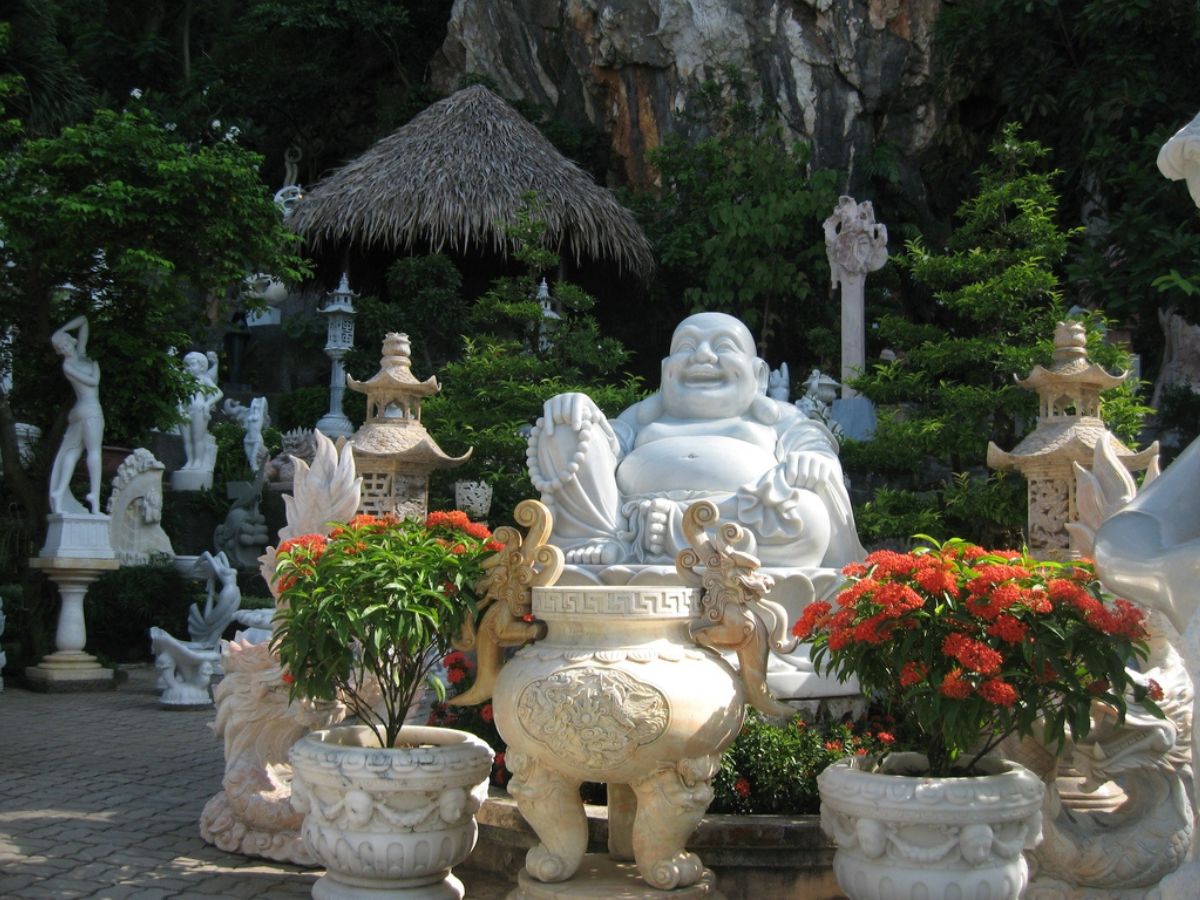1. Introduction about Non Nuoc Stone Carving Village

Non Nuoc Stone Carving Village is famous in Da Nang. (Source: Collected)
Non Nuoc Stone Carving Village is one of the most famous traditional craft villages in Da Nang, associated with hundreds of years of history, culture, and stone carving art. This place not only attracts tourists with its prime location at the foot of the Marble Mountains but also by its exquisite works, bearing the distinct mark of Vietnamese artisans.
1.1. Where is Non Nuoc Stone Carving Village?
Non Nuoc Stone Carving Village, located right at the foot of the scenic Marble Mountains in Hoa Hai ward, Ngu Hanh Son district, Da Nang city, is a place where nature and art blend perfectly. Only about 8 km southeast of Da Nang city center, the craft village is located on an important road connecting the city with the ancient capital of Hoi An, convenient for tourists to visit.
1.2. History of the formation and development of the craft village
Non Nuoc Stone Carving Village has a history dating back to the late 17th – early 18th century, when artisan Huynh Ba Quat from Thanh Hoa came to the Quang region. Recognizing the abundant marble resources at the Marble Mountains with white, blue, yellow, and pink hues, he initiated and passed down the stone carving trade to the local people, laying the foundation for a traditional craft village to exist and develop over many centuries.
Initially, products focused on household items such as mortars, pestles, pepper grinders, and medicine grinders. Over time, the crafting techniques became more sophisticated, and artisans began creating Buddha statues, mascots, and unique art pieces. The family-based inheritance of the trade and the master-apprentice model helped preserve stone carving techniques, while also developing the craft village sustainably across generations.
By 2025, Non Nuoc boasts over 500 processing facilities with diverse products exported to many countries. In 2014, Non Nuoc Stone Carving Village was recognized as a National Intangible Cultural Heritage, marking an important milestone honoring the artistic and traditional cultural values of Vietnam.
2. Cultural values and artistic characteristics of Non Nuoc Stone Carving Village

Non Nuoc Fine Art Stone Village is a National Intangible Cultural Heritage. (Source: Collected)
The cultural value and artistic characteristics of the Non Nuoc Fine Art Stone Village will open a journey to discover the quintessence forged through hundreds of years of history. Beyond artistic beauty, each work here holds cultural depth, beliefs, and the unique identity of the Quang Da land.
2.1. Stone Carving Craft – National Intangible Cultural Heritage
The recognition of the Non Nuoc Fine Art Stone Village as a National Intangible Cultural Heritage in 2014 not only affirms its hundreds of years of traditional value but also promotes efforts to preserve the nation's precious heritage. The craft village has become a vivid symbol of Da Nang's traditional craft, encouraging artisans to continue creating and preserving the soul of the ancient craft.
A special highlight of the craft village lies in its long-standing family tradition, where each household possesses its own secrets in selecting stone, shaping, and finishing products. At the same time, the master-apprentice model is maintained strongly in large workshops, where veteran artisans dedicate themselves to guiding the younger generation, helping the art of stone carving inherit the quintessence while diversifying styles and techniques.
2.2. Vietnamese – Cham Cultural Exchange in Sculpture
A unique highlight of the Non Nuoc Fine Art Stone Village lies in the exquisite blend between traditional Vietnamese fine arts and the spirit of ancient Champa art. Its special location in the Quang Da region – a place that was once a crossroads of many cultures – has left a deep imprint on every sculpted work.
Characteristic symbols such as dragons, phoenixes, lotus flowers, and bodhi leaves, along with religious architectural motifs, are skillfully carved by artisans onto each block of stone. Each product is not just a handicraft but also carries spiritual, religious meaning, and historical value, reflecting the richness and diversity of the Central Vietnamese cultural identity.
2.3. Outstanding Works at the Non Nuoc Fine Art Stone Village
When stepping into the Non Nuoc Fine Art Stone Village Da Nang, visitors will discover a treasure trove of diverse products, from traditional mortars and pestles, bowls, plates, and tea sets serving daily life. Feng Shui mascots such as unicorn statues, dragons, money frogs, elephant statues, and toad statues are exquisitely crafted, carrying meanings of good luck, prosperity, and fortune for the homeowner.
The highlight of the craft village is statues of Buddha, Guan Yin, Arhats, Cham statues, along with altars and reliefs with profound artistic and spiritual value. Artisans apply traditional handicraft techniques, meticulously caring for every detail. Many large products from the craft village have been placed in pagodas, historical sites, the imperial palaces of Hue, Hanoi, and exported internationally, contributing to promoting Da Nang's traditional craft globally.
3. Experiencing Activities at Non Nuoc Fine Art Stone Village 2025

Experience festivals at Non Nuoc stone carving village. (Source: Collected)
Visiting Non Nuoc stone carving village in 2025, visitors can not only admire exquisite works but also directly immerse themselves in many unique cultural and artistic activities. From visiting workshops to shopping for souvenirs, each experience leaves a unique and unforgettable impression.
3.1. Visiting carving workshops and interacting with artisans
The most impressive experience when visiting Non Nuoc stone carving village Da Nang is witnessing the entirely manual stone carving process. Visitors can observe from stone selection, sketching, chiseling, grinding, polishing to the completion of the artwork, where the artisan's hands still play the decisive role despite the support of modern equipment.
Some workshops even offer opportunities for visitors to try simple steps themselves, such as carving small symbols on stone or taking photos with artisans beside the works in progress. Through shared stories with veteran artisans, you will understand the meaning, history, and spiritual value of each artwork, while also feeling the passion for the craft and the spirit of passing down the trade preserved through generations in the Non Nuoc stone village.
3.2. Shopping for authentic Non Nuoc souvenirs and feng shui items
Non Nuoc stone carving village Da Nang is an ideal destination for those passionate about traditional sculpture art. Here, visitors can easily find precious stone jewelry such as rings, bracelets, small statues, feng shui mascots, Buddha – Quan Am statues, stone table and chair sets, as well as unique and compact souvenirs, all guaranteed for quality.
When shopping in Non Nuoc, visitors should prioritize reputable shops and workshops with village craft signs, request proof of stone origin, and full invoices. For worship items or feng shui products, consulting experts on age and destiny will help choose a gift that is both meaningful and suitable.
4. The role of Non Nuoc stone carving village in Da Nang's tourism development

Non Nuoc Stone Carving Village is an attractive tourist destination. (Source: Collected)
Non Nuoc Stone Carving Village is not only a place that preserves the quintessence of traditional craft but has also become an important highlight on the Da Nang tourism map. The cultural, artistic, and economic values that the craft village brings have contributed to creating a special attraction, connecting visitors' experiences with local history and identity.
4.1. The Craft Village – A Must-Visit Destination on Your City Exploration Journey
Non Nuoc Stone Carving Village in Da Nang is not only famous domestically but also attracts many international visitors who love exploring folk art, history, and Central Vietnamese culture. The special attraction of the craft village lies in its preservation of the stone carving tradition through many generations, creating an authentic and vivid experience for visitors.
Its convenient location near the Ngu Hanh Son (Marble Mountains) complex helps form an ideal continuous sightseeing route. After admiring the exquisite sculptures, visitors can easily explore the surrounding caves, ancient pagodas, and natural landscapes, offering an impressive journey combining culture, spirituality, and traditional art.
4.2. The Stone Carving Village and its Socio-Economic Contributions
With over 500 processing workshops, Non Nuoc Stone Carving Village has become a center for job creation for thousands of local workers, contributing to economic stability and improving community livelihoods. The craft village not only preserves the traditional stone carving craft but also develops accompanying services such as transportation, sales, and product management, creating a sustainable value chain for residents.
Many large-scale works from the village have been displayed at important projects in Hue, Hanoi, and Ho Chi Minh City, and exported to many countries, helping to promote Vietnamese stone art internationally. As a result, Non Nuoc stone village is positioned as a leading stone carving center in the region, contributing to enhancing Da Nang's cultural tourism and placing the craft village's brand on the world map.
5. Guide to Traveling and Visiting Non Nuoc Stone Carving Village 2025
Non Nuoc Stone Carving Village is conveniently located just a few kilometers from the center of Da Nang city, making travel and visits quite easy. With many transportation options and itineraries combined with Ngu Hanh Son, visitors can enjoy a complete trip, exploring traditional carving art while immersing themselves in the unique natural landscapes and culture of Central Vietnam.
5.1. How to Travel from Da Nang City Center to Non Nuoc Stone Carving Village
To explore Non Nuoc Stone Carving Village, visitors have many flexible transportation options.
Renting a motorbike in the city center for about 100,000 VND/day is a popular option, allowing freedom to travel along two main routes: via Dragon Bridge – Vo Van Kiet – Vo Nguyen Giap – Truong Sa or via Ngo Quyen – Ngu Hanh Son – Le Van Hien.
For larger groups or families, taxis and ride-hailing services priced at 150,000–200,000 VND/trip offer convenience and comfort.
Additionally, visitors can opt for bus routes 1 and 4 from Da Nang to Hoi An, alighting in the Ngu Hanh Son area and walking to the village.
Many travel agencies also organize half-day tours combining visits to the stone village and Ngu Hanh Son, accompanied by professional guides, offering a complete experience of Da Nang's stone carving art and traditional culture.

Visiting Sun World Ba Na Hills when traveling to Da Nang. (Source: Collected)
One of the interesting experiences when coming to Da Nang is combining sightseeing with shopping and exploring traditional craft villages.
You can start your morning itinerary by visiting the Non Nuoc Stone Carving Village in Da Nang, famous for its exquisite marble carvings. Here, visitors can learn about the handicraft process and choose unique souvenirs that bear the imprint of Central Vietnamese culture. In particular, products such as feng shui statues, bracelets, or stone mascots are loved by many tourists for their spiritual significance and artistic value.
In the afternoon, continue your journey with the unmissable destination of Sun World Ba Na Hills. Located about 25 km from the city center, this famous tourist area offers a wonderful experience with a record-breaking cable car, the world-famous Golden Bridge, and many classical European architectural works. This is an ideal place to enjoy the fresh air, participate in entertainment games, and keep beautiful souvenir photos.
In the evening, you can return to the city center, enjoy fresh seafood by My Khe beach, or stroll along the Han River to watch the Dragon Bridge breathe fire and water. Such a combined itinerary will not only help you fully explore the cultural, natural, and entertainment beauty of Da Nang, but also bring many unforgettable memories to your trip.
6. Notes when exploring the Non Nuoc Stone Carving Village

Visitors to Non Nuoc Stone Carving Village should maintain a polite attitude. (Source: Collected)
Exploring Non Nuoc Stone Carving Village is not only an opportunity to shop for exquisite works but also a journey to learn about long-standing cultural values. To make the visit complete, visitors should note some important points regarding shopping, etiquette, and experiences in the craft village.
When shopping at Non Nuoc Stone Carving Village, visitors should prioritize choosing products that bear the unique imprint of the craft village and suit their needs.
Always ask for information about the stone's origin and consider feng shui elements when choosing mascots, Buddha statues, or spiritual items.
The most beautiful photo spots in the village include workshops, outdoor statues, stone gates, and kilns, but you should ask for permission beforehand and choose polite attire when taking photos with artisans.
Etiquette when visiting the craft village requires respect, do not touch unfinished spiritual works without permission, avoid crowding or disrupting the production process.
Maintain a polite attitude towards artisans, adhere to the rules in the workshops, and minimize noise.
Participating in experiential activities with a spirit of learning will help you clearly understand traditional cultural values, while also appreciating the meticulousness and dedication in each artistic product of the Non Nuoc Stone Carving Village.
Non Nuoc Stone Carving Village is a vivid testament to the fusion of tradition and modernity, offering visitors a unique cultural experience right in the heart of Da Nang. Visiting here in 2025, you will not only admire the quintessence of stone carving art but can also bring home exquisite handicrafts, preserving enduring spiritual values over time.








